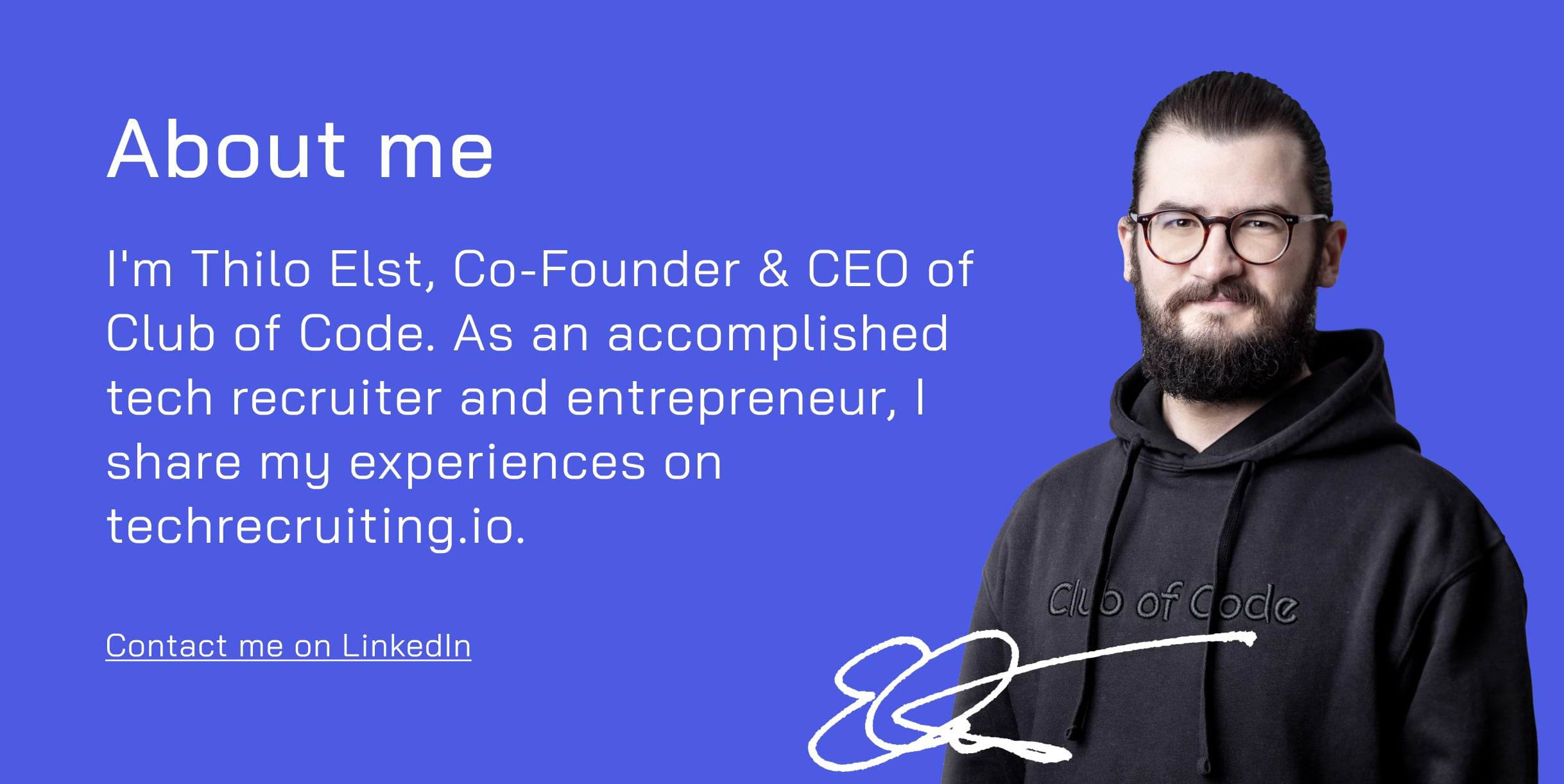Looking for software developers and other IT talent? You're not alone. There are currently 137,000 unfilled IT positions. So your target group can choose where they want to work. So it's high time to optimize your tech recruiting and make yourself even more attractive to your target group.
Definition: What is tech recruiting?
Tech recruiting is the recruitment and hiring of software developers and other IT talent in the software sector. In addition to full-stack, frontend and backend developers, this also includes DevOps engineers, embedded systems engineers and cloud architects, for example. Tech recruiting is thus a target group-specific category of recruiting and includes a special recruiting process. The special features of tech recruiting are the increased use of active sourcing and the integration of tech interviews as part of the selection process.
Tech recruiting: how to optimize your active sourcing
Active sourcing is almost essential for effective tech recruiting. Rarely do companies swim in a sea of developer applications, through which they can fill every developer position. Good quality ones at that. The really good developers don't need to apply anyway. They are poached. And they can choose their employers. And in order for you to be the employer that attracts the really good developers, you have to find them and actively approach them yourself.
If you're not familiar with active sourcing at all, learn all about it in this blog article: Active Sourcing: Everything you need to know.
Active Sourcing: Understand Tech Positions and Terms
If you already have experience with active sourcing, I recommend that you take an in-depth look at tech positions and the associated technologies. It's not so much about learning superficial vocabulary, for example that there is Java and JavaScript, but rather an understanding of the interrelationships of the technologies. Which frameworks belong to which programming language? Which technologies are often used together? What is the hierarchy of a tech stack?
If you understand the hierarchy of the tech stack, you can evaluate profiles much more easily. To do this, you can always ask yourself (and your department) how hard it is to learn a particular technology. Let's say you're looking for a DevOps engineer who should be able to do Kubernetes, Kubernetes is a very relevant keyword because it's a complex technology that's not easy to learn. If, however, you are looking for a frontend engineer who should ideally be able to do MaterialUI, then MaterialUI is a negligible keyword because it is very easy to use, even if you have not worked with it before.
A structure of the relevance of keywords could be, for example:
High relevance
- Programming languages
- Optional: Frameworks
Medium relevance
- Frameworks
- Optional: working methods like Scrum, Waterfall,...
Low relevance
- Libraries
The structure also depends on the requirements of the department. Therefore, it is best to talk to your colleagues from the department about which keywords are relevant for the respective job posting. From my experience, you can already find the matching profiles with the top 3 of the list.
In terms of the interrelationships of technologies and understanding the world of software development, this blog also accompanies you.
Active Sourcing: Evaluate LinkedIn profiles correctly
We have now understood which technologies are really important for us and which keywords we can turn a blind eye to. In practical implementation, however, we find profiles of different types. From fully completed to little completed LinkedIn profiles, everything is there. How do you evaluate them correctly now?
Strictly speaking, it is not feasible at all. A developer with a well-filled LinkedIn profile is no better than one with a little-filled LinkedIn profile. What then would be the case with someone without a LinkedIn profile? We are always dependent on what our counterpart reveals and what not. But even the available information in the profile says nothing about whether we are dealing with a good or average developer. Ultimately, we find that out in the tech interview at the earliest, but more likely still during the probationary period. For active sourcing, however, this still means that we can address the most suitable profiles based on our prioritized tech stack. In my experience, two points are important here:
- Few filled profiles are unpopular in the rating, but can still lead to success. A developer who does not want to be contacted knows that all he has to do is delete his keywords and he will no longer be found and thus will not be contacted. Therefore, it is always worth a try and it is also just another friendly request that is written quickly.
- Profiles that can do "everything" usually can't do anything right. Unfortunately, developers often make things difficult for themselves when they complain that recruiters have no idea about their job. For example, if we are looking for a Java developer and the profile shows C#, JavaScript, PHP, Python, C++ and C as programming languages in addition to the keywords we are looking for, it looks like the developer can do a lot, but no one can guess what he is really good at. Sometimes he has only spent an hour with Python or similar and writes it as a skill in his profile.
A good developer profile has a certain stringency and a clear tech stack. Overloaded profiles that have all technologies may not be good developers either.

Tech recruiting: How to become attractive to developers
In addition to active sourcing, strong employer branding is important for your tech recruiting. This applies both externally and internally. With the right employer branding, you not only promote your company to potential new employees. It also helps to ensure that existing employees don't leave the company. And it's always cheaper if existing developers don't leave in the first place than if you are confronted with high recruiting and training costs for new developers. Make your company more attractive for developers. So attractive that other companies have nothing to do with your existing developers applying elsewhere or potential new developers not choosing you.
What is important to developers?
To do that, we need to understand what developers really care about. Of course, this can never be seen in a blanket way. However, certain criteria are emerging that are mentioned again and again in surveys. For example, in the Stackoverflow Developer Survey.
Salary & Benefits
In a world where developers get job offers every week, it's all about money. Everyone wants to sell their time at the best possible price. In addition to salary, this can also include other benefits, such as a company car or stock options.
Sense & good product
If you can't overpay to compete for developers, the second point is sense and a great product. For really exciting technology that may one day change the world or otherwise give the developer a feeling of working on something great or valuable, salary can also be waived. Of course, the storytelling has to be right. But one of the two, a good salary or a great product, is the basis for your recruiting success.
Tech Stack & Continuing Education
The next point includes the technologies used. Developers usually use a certain tech stack that they have acquired in the past. And they always like to learn. Using modern technologies or even influencing the expansion of the company's tech stack is interesting for many developers. This also includes the topic of continuing education. Many developers are self-taught, having acquired most of their knowledge and skills themselves. Accordingly, they are interested in always keeping their knowledge up to date and expanding it further. 80 % of developers also program privately, for example. Figuratively speaking, they come home from programming at work and continue programming privately. You can support this with an attractive training budget.
Technical infrastructure
A technical application area, such as the development of software, also requires a good infrastructure. With the right equipment, which the developer can ideally choose himself, you become attractive as an employer and provide the optimal conditions for the developer to work well. Laptop, PC, large screens, many small screens, height-adjustable desks; every developer has different preferences and you can respond to these. Therefore, allocate a budget for technical equipment and offer your developers the optimal infrastructure in terms of hardware and software.
Remote work
Another important point on the way to becoming an attractive employer is the working environment. Remote working is modern. Especially in software development. Approximately 80 % of companies offer at least partial remote work, which is popular with developers. So if you're not remote at all yet, you're narrowing both your pool of developers and your employer appeal. Even in the case of on-site office work, you should pay attention to the needs of developers. Software development requires a lot of concentration and focus. In this context, you may hear the saying that someone is "in the tunnel" or "in the flow" when you block out everything else and are unresponsive. This type of work is usually incompatible with open-plan offices, for example, where there are many external stimuli. Therefore, provide quiet workplaces where developers can focus and concentrate on their work. And if there is only the open-plan office, you can at least support with noise-cancelling headphones.
What else can you do?
Perhaps you have already found room for improvement in the previous points. Of course, this does not only apply to the attractiveness for potential new developers, but also for developers who are already working for you. Prepare a really good working environment for them, too, according to the points mentioned above. But also ask them what would make the working environment more attractive for them. Because, as I said, it's cheaper if existing developers don't leave in the first place than to find and hire new developers. This may also give rise to new ideas, such as small internal hackathons, to which developers from outside may also be invited in the future.
Tech recruiting: How to optimize your approach
We now know what is important to developers and can exploit this in good storytelling when addressing them. The key is to communicate differently than everyone else. After all, developers already have enough standard emails with little content in their inboxes.
Communicate your branding
What makes you special or even unique as an employer? Why does your product need it? And why should the developer you are addressing invest his time in it? Make it clear why it is time well spent for him. This can be, as I said, sense and a great product or simply attractive pay. To be able to keep a developer permanently, one of the two criteria must be fulfilled. And you can use this criterion as a hook in your approach.
Communicate salary bands
To shine in the existing competition of job offers, it is important to communicate transparently. We all work for money and no one wants to be financially worse off with the next position. Therefore, communicate salary bands as early as possible. Optimally, already in the first approach. This way the developer knows if it's worth talking about or not and you both save time if it's not. Be aware that developers can ask for a lot of money at the moment, because they have a wide range of job offers and there is almost always someone who will pay the high salary. You should face this reality with open eyes and come up with communication strategies on what you can offer developers as an alternative if you don't pay the high salaries.
Involve the faculty
When it comes to "cover letters", there is a certain hierarchy of those who write. You can use this to increase your feedback rate with developers. The closer the contact is to the future job of the person being contacted, the better. From my experience, this results in the following hierarchy:
- Department (CTO, future supervisor, future colleagues)
- Human Resources (Recruiter)
- external employees (freelance recruiters)
- Personnel service provider
This is similar to dating. If I get to know the person I'm dating directly myself, a friend tells me about the person (recruiter in this case) or even a dating agency (staffing agency in this case). The feeling is always a little different. Therefore, use the department and its accounts to increase your joint recruiting success.
Summary
Tech recruiting is one of the most challenging fields you can work in right now. Good software developers are scarce and highly competitive. However, to recruit successfully in the fierce competition, you can optimize your active sourcing, your understanding of tech terms, and your employer branding to attract good developers and keep them with the company for the long term. You can achieve this through the right understanding of tech stacks and their hierarchy in active sourcing and by taking developer wishes into account in employer branding and its communication.

Tech recruiting: What is important to software developers?
In addition to salary and benefits, the most important things for software developers are continuing education, working with good hardware and software, and being able to work flexibly and remotely.
What is Technical Recruiting?
Technical recruiting (or tech recruiting) is the recruitment of software developers and other IT talent from the software sector. This includes jobs such as full stack developers, DevOps engineers and cloud architects.
Definition: What is employer branding?
Employer branding encompasses all the measures that a company can use to strengthen its employer brand and thus its attractiveness to existing and potential employees.
